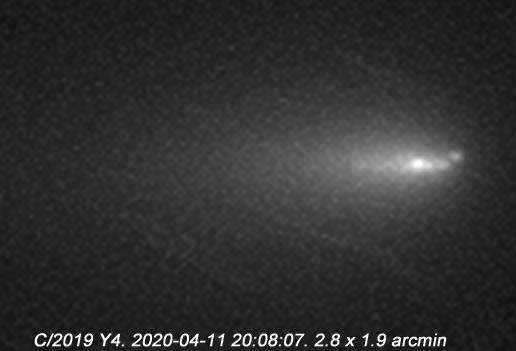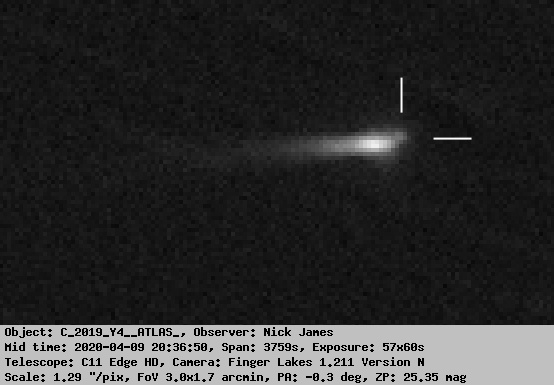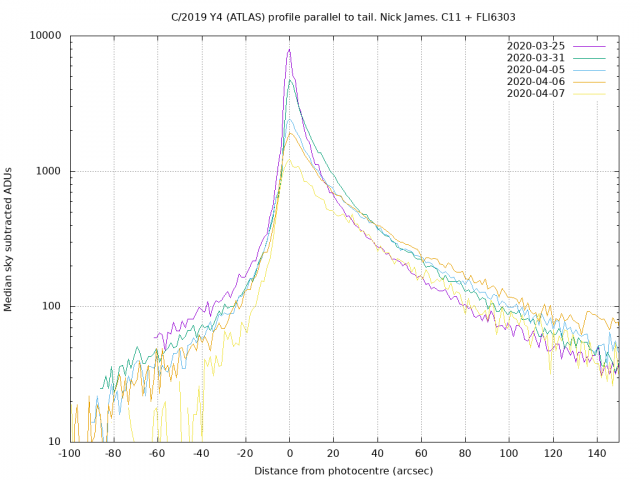Forum Replies Created
-
AuthorPosts
-
 Nick JamesParticipant
Nick JamesParticipantThanks for that Steve. It is always fun to see a spacecraft go over only 15 mins or so after it has launched from the Cape. This one will be particularly interesting because of the manned aspect. Sometimes there are interesting things to see as well if the second stage of Falcon 9 is venting propellants.
 Nick JamesParticipant
Nick JamesParticipantProxima is too far south for us at a declination of 62 deg S. Wolf 359 is a bit further away (7.9 light years compared to proxima’s 4.2) but it is visible from the northern hemisphere as faint red dwarf in Leo.
 Nick JamesParticipant
Nick JamesParticipantIt’s a nice outreach activity and the baseline is certainly much larger than the 2au baseline that Gaia has but the resolution of the LORRI camera on NH in 4×4 bin mode is only around 5 arcsec (2.3 m FL, 13.5 um pixels). The current Gaia DR2 error for the parallax of Proxima is 0.2 milli-arcsec (mas). Assuming a high SNR in the images LORRI might get astrometry accurate to 50-100 mas. The 25 times improvement in baseline won’t compensate for the factor of 250 loss in precision. The NASA publicity doesn’t really make this very clear.
 Nick JamesParticipant
Nick JamesParticipantJohn,
Yes, the current orbit from MPC for C/2019 Y1 (ATLAS) gives positions which are off by 5′.2 in RA and 12′.8 in Dec.
The position from JPL Horizons is much closer.
Mid time: 2020-04-15 20:23:52, S up.
 Nick JamesParticipant
Nick JamesParticipantThe weather didn’t cooperate last night so I have no new images of C/2019 Y4 (ATLAS). I’ve been playing with images taken over the last few nights using FITSwork and iterative Gaussian sharpening (thanks to Nick Haigh for putting me on to this). These images show the development of the inner coma region over three nights. The first two were taken with by camera in 1×1 bin mode. Unfortunately I don’t have this for the last night so I have used a resampled versin of my normal 2×2 bin mode. All use the same Gaussian sharpening params (r=4.13, 20 iterations, 100% strength). You can see the components separating as the move relative to one another.

 Nick JamesParticipant
Nick JamesParticipantNice image. Yes, it is still surprisingly good given all the turmoil going on in the centre!
 Nick JamesParticipant
Nick JamesParticipantThe amazing run of clear nights continues combined with being at home every night means that I have imaged this comet on 7 consecutive nights now. This early stack tonight is an weak unsharp mask on the coma region showing the various components. The one to the top right (NW) is probably the residual nucleus.

 Nick JamesParticipant
Nick JamesParticipantAbsolutely sure. This is a sigma-clip stack tracked on the comet’s motion. Stars will be faint streaks. Also this appears on multiple stacks always in the same position relative to the comet. And loads of other observers have imaged it…
 Nick JamesParticipant
Nick JamesParticipantThis image from tonight is at an image scale of 1″.29 per pixel with FWHM = 2″.9. It is an average stack of 57x60s frames with local flux subtracted using a 6×6 median. It is upsampled by a factor of 4 for display. There is a clear condensation to the NW of the bright extended coma. Interestingly, if you do astrometry on this condensation you get a position which is within 2 arcsec of the position predicted by the orbit using astrometry up to March 25. Current astrometry which is centroided on the bright elliptical coma is off by around 11 arcsec now. This condensation wasn’t visible in my images last night.
Is it what remains of the nucleus? We’ll find out over the next few days.

 Nick JamesParticipant
Nick JamesParticipantThat is very interesting, particularly the continuing strong C2 emission line. We now seem to have a cloud of rubble moving down the tail but the total magnitude is also falling which would imply that there was no sudden release of gas into the coma at the breakup. This implies that the comet had pretty much exhausted its volatiles before it broke up so we should now see the outer come fade and dissipate since it has no source at the centre. It would be good to follow this spectroscopically as long as you can.
 Nick JamesParticipant
Nick JamesParticipantYes, I’m afraid C/2019 Y4 (ATLAS) looks as if it will soon be an ex-comet. Only a week ago I gave our first webinar talking about prospects for this object. Now I think it is probably a cloud of rubble. As Comet section Director I’m not having much luck with comets!
In my images over the last few nights I have not seen any fragments in the tail. What I have seen is a gradual reduction in the peak pixel ADU count and a flattening/broadening of the downtail coma brightness profile. This plot shows a cut through the photocentre aligned on the tail PA (positive offsets are tailward) for five nights from March 25 to April 7. You can see that peak pixel ADU falls from around 8000 to 1200 in that time (a fade of around 2 magnitudes) and the profile is broader with a more gradual tailward slope in the later images. It looks to me as if the nucleus has completely fragmented and what we are seeing is a cloud of rubble migrating down the tail. This explains the large astrometric residuals in RA since the photometric centroid is no longer aligned with the original nucleus.
If this is correct the future of this comet is as a fainter and fainter diffuse rubble pile. Let’s see what happens and keep this under observation as long as possible. We have a ringside seat to watch the distruction of a Solar System object.

 Nick JamesParticipant
Nick JamesParticipantAs long as that only involves virtual money that’s fine.
 Nick JamesParticipant
Nick JamesParticipantI do have some Thatchers too although it is running out.
 Nick JamesParticipant
Nick JamesParticipantGreat memories and I’m already looking forward to next year when hopefully things will be back to normal. I’ll really miss it this year though. Such a shame given all the effort that Ann and Alan and others put into arranging it.
Perhaps we should set up a virtual meeting in the bar on Saturday night. I have plenty of beer since my local brewery is making home deliveries and I’m trying to keep it in business.
28 March 2020 at 8:37 pm in reply to: Help needed :) Image Venus and the Moon for Parallax Project #582176 Nick JamesParticipant
Nick JamesParticipantMine from Chelmsford is here (attached in full res). It was taken at 19:32 since clouds were coming in. I have a less overexposed one if that helps. I do have an image at 19:52 which is the closest to 8pm I have.
 Nick JamesParticipant
Nick JamesParticipantI’ve just added another video from John. This one is about observing the ISS. Go you our Youtube channel to watch it.
 Nick JamesParticipant
Nick JamesParticipantTry the two comets C/2017 T2 and C/2019 Y4. They are both well placed and around mag 8. I know that they are fuzzy and that they move but I’m sure that go-to mount will find them!
 Nick JamesParticipant
Nick JamesParticipantIt is definitely worth a trawl around the Section pages. There is loads of interesting stuff to read on this site. The old Lunar Section publications are definitely worth a read, particularly if you knew or know of some of the characters therein. Can I also put in a plug for the old Comet Section circulars to from 1973 onwards. They are here.
 Nick JamesParticipant
Nick JamesParticipantYes, me too on my meteor cameras. The number of aircraft in the south east of England is falling rapidly. A very small positive amongst a sea of negative. It looks as if we will have several months of this.
 Nick JamesParticipant
Nick JamesParticipantIf they cross Denis I would be really worried since the spaceport is on the north coast and they will be aiming north on the one day a year that it is calm enough to launch…
-
AuthorPosts
